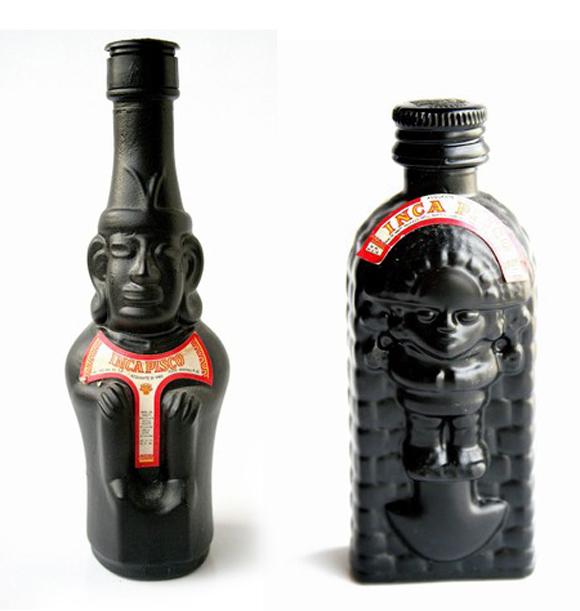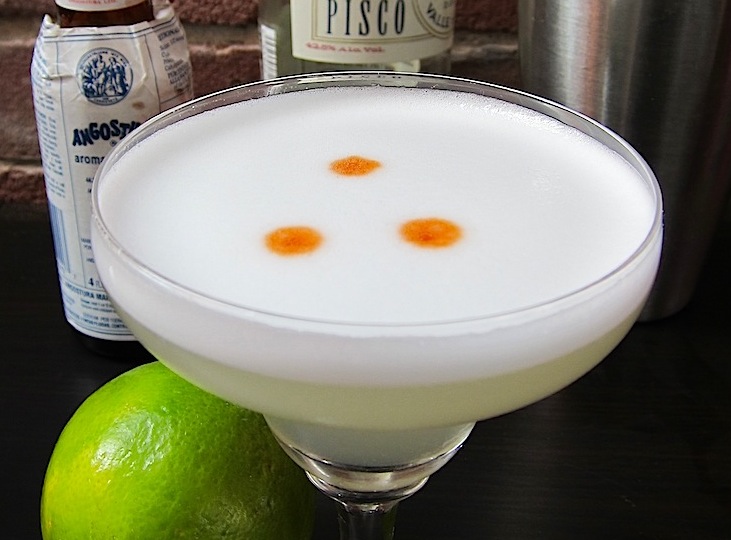 I love new books because they challenge me to try new techniques or new ingredients. Ever since adding the Aruba to my repertoire last month, I've been on an egg white kick. I love the froth and texture that it adds to drinks, and making drinks with raw eggs never fails to impress folks. This month's drink, the Pisco Sour, continues my egg white trend using a new ingredient - Chilean (or Peruvian) brandy called Pisco.
I love new books because they challenge me to try new techniques or new ingredients. Ever since adding the Aruba to my repertoire last month, I've been on an egg white kick. I love the froth and texture that it adds to drinks, and making drinks with raw eggs never fails to impress folks. This month's drink, the Pisco Sour, continues my egg white trend using a new ingredient - Chilean (or Peruvian) brandy called Pisco.
All brandy is made from distilled grapes. Just as in wine, different grapes lend themselves to slightly different flavored brandies, leading to flavor differences between the classic French Cognacs or Armagnacs. There are a few other significant steps in the distillation process that lend unique flavors - for instance, Armagnac is traditionally made using a column still while Cognac is made using a copper pot still (similar to Irish whiskey). The final step in producing fine brandy is to allow it to age in oak casks for a period of time. The oak gives the otherwise clear spirit its distinctive golden color and imparts much of the caramel flavor to brandies.
Pisco is different in that it is never aged. It is distilled from a blend of either Chilean or Peruvian grapes in a copper pot still, but it is then placed in either glass or stainless steel containers to rest for a period of time. The result is a clear liquor that still retains a strong "fruit-forward" flavor that stands out all the more because of the lack of oak-infused flavor. Right now, Brandy is my favorite cocktail base - Pisco is fun to mix with because its strong floral notes make it just different enough that it totally changes the flavor profile of almost any brandy drink.
Here is the recipe for the Pisco Sour, courtesy of the PDT Cocktail book:
In a cocktail shaker, combine:
2 oz Pisco*
3/4 oz lime juice
3/4 oz simple syrup
1 egg white
Dry shake these ingredients for 5-10 seconds to allow the egg white to emulsify. Add ice and shake for 10 seconds until frothy. Strain and serve in a coupe glass - you should have a nice 1/2 to 1 inch or so of foam on top of your drink. Add 3-4 drops of Angostura bitters on top and serve.
*A quick note on Pisco brands: Pisco comes in several varieties - Chilean, Peruvian, and now several American distillers also make Pisco. There is debate which country - Peru or Chile - gave rise to Pisco. It appears that Peru has a better claim, but I use Chilean "Capel" Pisco, as it is the most affordable. You can find decent Capel Pisco for under $15 a bottle. Peruvian Machu Pisco is a much nicer spirit, but will cost closer to $30-35.
Enjoy your Pisco Sour!
Pisco is different in that it is never aged. It is distilled from a blend of either Chilean or Peruvian grapes in a copper pot still, but it is then placed in either glass or stainless steel containers to rest for a period of time. The result is a clear liquor that still retains a strong "fruit-forward" flavor that stands out all the more because of the lack of oak-infused flavor. Right now, Brandy is my favorite cocktail base - Pisco is fun to mix with because its strong floral notes make it just different enough that it totally changes the flavor profile of almost any brandy drink.
Here is the recipe for the Pisco Sour, courtesy of the PDT Cocktail book:
In a cocktail shaker, combine:
2 oz Pisco*
3/4 oz lime juice
3/4 oz simple syrup
1 egg white
Dry shake these ingredients for 5-10 seconds to allow the egg white to emulsify. Add ice and shake for 10 seconds until frothy. Strain and serve in a coupe glass - you should have a nice 1/2 to 1 inch or so of foam on top of your drink. Add 3-4 drops of Angostura bitters on top and serve.
*A quick note on Pisco brands: Pisco comes in several varieties - Chilean, Peruvian, and now several American distillers also make Pisco. There is debate which country - Peru or Chile - gave rise to Pisco. It appears that Peru has a better claim, but I use Chilean "Capel" Pisco, as it is the most affordable. You can find decent Capel Pisco for under $15 a bottle. Peruvian Machu Pisco is a much nicer spirit, but will cost closer to $30-35.
Enjoy your Pisco Sour!




